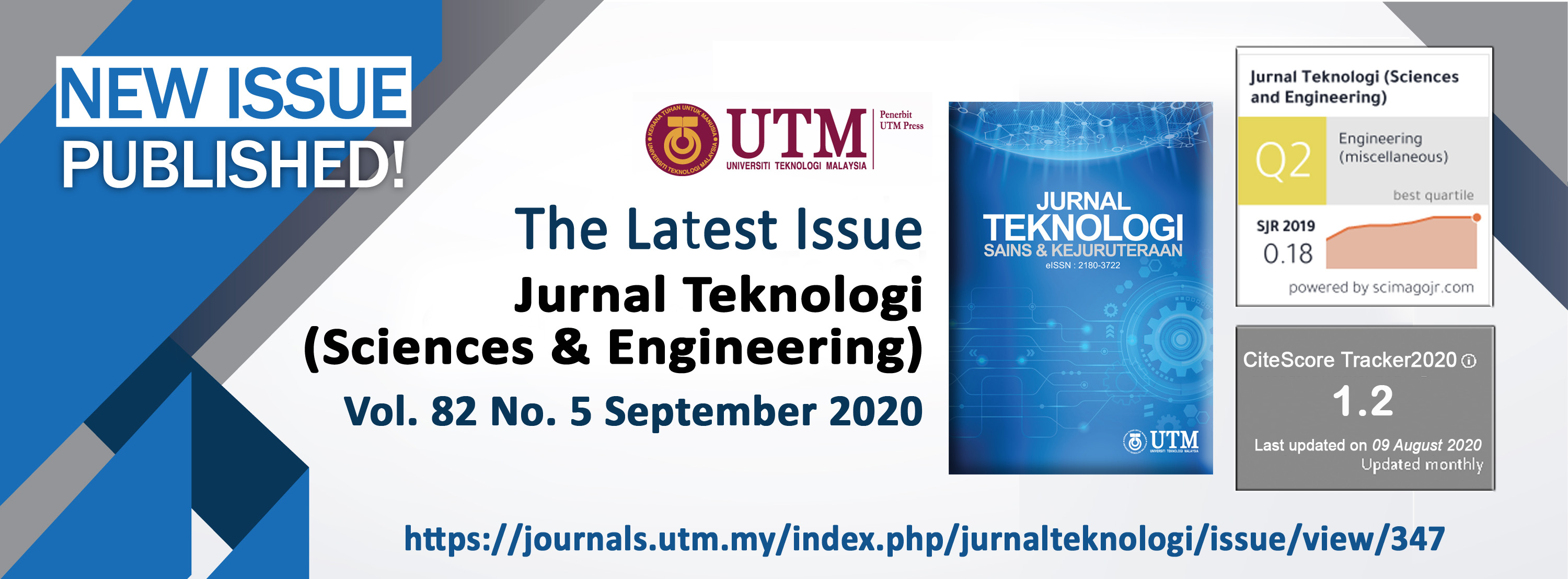EFFECT OF AIR FLOW OBSTRUCTION IN A CONDENSING UNIT ON SPLIT AIR CONDITIONER PERFORMANCE
DOI:
https://doi.org/10.11113/jt.v82.14185Keywords:
Air flow obstruction, coefficient of performance, condensing unit, cooling capacityAbstract
Obstructions of air flow in the outdoor unit could block the condenser air flow and reduce its heat rejection As a result, it could decrease the performance of a room air conditioning system. The paper presents the effects of the air flow obstruction of a condensing unit on the performance of a split-type air conditioner with refrigerant R410A. The study was conducted experimentally by employing front and side obstructions with varied distance from the condensing unit. The front obstruction of 100 cm height was applied at varied distance from 10 cm to 100 cm, while the side obstruction of the same height was applied at distance of 5, 10, and 15 cm. The presence of air flow obstructions results in the decrease of cooling capacity and coefficient of performance (COP). On the other hand, it increases the input power of the AC unit. From the experiment, it is obvious that the distance of front obstruction of 10 cm results in the reduction of cooling capacity by 46% and COP by 56%. It is also revealed that the distance of the front obstruction of 50 cm or more has no significant effect for the performance of the air conditioning unit. In addition, the side obstructions have the less significant effect than that of the front obstruction.
References
Chow, T. T., Lin, Z., and Wang, Q. W. 2001. Flow Analysis of Condenser Cooling Air Delivery via Building Light Well. Applied Thermal Engineering. 21: 831-843.
https://doi.org/10.1016/S1359-4311(00)00084-3.
Chow, T. T., Lin, Z., and Yang, X. Y. 2002. Placement of Condensing Units of Split-type Air-conditioners at Low-rise Residences. Applied Thermal Engineering. 22: 1431-1444. https://doi.org/10.1016/S1359-4311(02)00068-6.
Nada, S. A. and Said, M. A. 2018. Solutions of Thermal Performance Problems of Installing AC Outdoor Units in Buildings Light Wells Using Mechanical Ventilations. Applied Thermal Engineering. 131: 295-310.
https://doi.org/10.1016/j.applthermaleng.2017.12.016.
Xue, H., Xu, B., Wu, J., and Wei, Y. 2007. Prediction of Temperature Rise Near Condensing Units in the Confined Space of a High-rise Building. Building and Environment. 42: 2480-2487.
https://doi.org/10.1016/j.buildenv.2006.06.011.
Yau, Y. H. and Pean H. L. 2014. The Performance Study of a Split Type Air Conditioning System in the Tropics, as Affected by Weather. Energy and Buildings. 72: 1-7. https://doi.org/10.1016/j.enbuild.2013.12.010.
Bassiouny R. 2009. Evaluating the Effect of the Space Surrounding the Condenser of a Household Refrigerator. International Journal of Refrigeration. 32: 1645-1656. https://doi.org/10.1016/j.ijrefrig.2009.03.011.
Datta, S. P., Das, P. K., and Mukhopadhyay, S., 2014. Obstructed Airflow through the Condenser of an Automotive Air Conditioner – Effects on the Condenser and the Overall Performance of the System. Applied Thermal Engineering. 70: 925-934. https://doi.org/10.1016/j.applthermaleng.2014.05.066.
Blecich, P. 2015. Experimental Investigation of the Effects of Airflow Nonuniformity on Performance of a Fin-and-Tube Heat Exchanger. International Journal of Refrigeration. 59: 65-74.
https://doi.org/10.1016/j.ijrefrig.2015.06.029.
Avara, A. and Daneshgar, E. 2008. Optimum Placement of Condensing Units of Split-type Air-conditioners by Numerical Simulation. Energy and Buildings. 40: 1268-1272. https://doi.org/10.1016/j.enbuild.2007.11.011.
Huang, X., Chen, L., Kong, Y., Yang, L., and Du, X. 2018. Effects of Geometric Structures of Air Deflectors on Thermo-flow Performances of Air-cooled Condenser. International Journal of Heat and Mass Transfer. 118: 1022-1039.
https://doi.org/10.1016/j.ijheatmasstransfer.2017.11.071.
Huang, X., Chen, L., Yang, L., Du, X., and Yang, Y. 2019. Cooling Performance Enhancement of Air-cooled Condensers by Guiding Air Flow. Energies. 12:1-28.
https://doi.org/10.3390/en12183503.
Duan, R., Wang, X., Song, Y., and Liu, J. 2016. Influence of Air-conditioning Outdoor Unit Arrangement Strategy on Energy Consumption. Procedia Engineering. 146: 350-358. https://doi.org/10.1016/j.proeng.2016.06.409.
Kumbhar, A., Gulhane, N., and Pandure, S. 2017. Effect of Various Parameters on Working Condition of Chiller. Energy Procedia. 109: 479-486.
https://doi.org/10.1016/j.egypro.2017.03.076.
Elsayed, A. O. and Hariri, A. S. 2011. Effect of Condenser Air Flow on the qPerformance of Split Air Conditioner. World Renewable Energy Congress, 8-13 May 2011. Sweden. 2134-2141.
Jin, W., Zheng, Y., Zhang, Y., Jiang, Y. 2015. Experimental Study of Factors Affecting the Performance of a Semi Enclosed Outdoor Air-conditioning Unit. Procedia Engineering. 121: 1713-1720.
https://doi.org/10.1016/j.proeng.2015.09.138.
Ryu, K., Lee, K. S., and Kim, B. S. 2013. Optimum Placement of Top Discharge Outdoor Unit Installed Near a Wall. Energy and Buildings. 59: 228-235.
https://doi.org/10.1016/j.enbuild.2012.12.019.
Choi, S. H., Lee, K. S., and Kim, B. S. 2005. Effects of Stacked Condensers in a High-rise Apartment Building. Energy. 30: 968-981.
Downloads
Published
Issue
Section
License
Copyright of articles that appear in Jurnal Teknologi belongs exclusively to Penerbit Universiti Teknologi Malaysia (Penerbit UTM Press). This copyright covers the rights to reproduce the article, including reprints, electronic reproductions, or any other reproductions of similar nature.
















